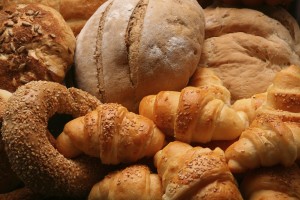 Bread is an ancient staple in man’s diet. It used to be a simple food that provides energy for our daily needs.
Bread is an ancient staple in man’s diet. It used to be a simple food that provides energy for our daily needs.
But the bread today is very different from that of the past. The type of wheat, the yeast, and the ingredients used in the modern bread are no longer the same as the traditional bread.
The companies that mass-produce sliced bread are allowed to put dozens of chemicals, additives, and other unnecessary things into their products. Some of these are strongly linked to health issues, yet are still approved by the FDA for use in our food.
That is why it’s vital that you understand which bread to watch out for. We have done a lot of research on bread, what are the ingredients used, and why you should avoid.
Why You Should Never Eat White Bread
Whole grains are made of three layers. The outermost layer has the most fiber, the middle layer has the most nutrients, and the inner layer is mostly starch. White bread is made up only of the inner layer of the grains, and so it lacks the fiber and nutrients that whole grain breads contain.
The grain, stripped of its two outer layers, is then put through a high-speed mill in order to grind it up. These mills produce a lot of heat, which depletes even more nutrients from the already processed grains.
Once the grain is ground into flour, it is bleached. One common chemical used to bleach white flour is chlorine oxide. Chlorine oxide is a powerful irritant that is dangerous to inhale, and yet it is used to make food.
You’ll see below that bread is filled with many other chemicals, some of which are obviously dangerous. Regardless, of all bread types, white bread is the worst of them all.
Next, let’s take a look at the different ingredients in bread that you should look out for.
Additives Found In Many Store-Bought Breads:
- High fructose corn syrup: Most people know that HFCS is really bad for us. It’s in most processed foods even though it can do quite a bit of damage to our bodies. HFCS can cause and worsen diabetes, weaken the immune system, and disrupt metabolic functions in the body.
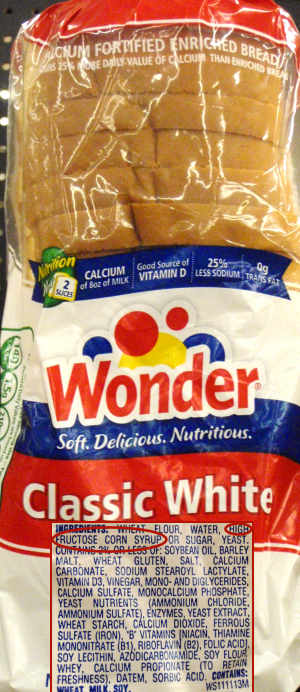
- Calcium proprionate: This ingredient increases inflammation along the gastrointestinal tract, which can lead to ulcers. A study in the Journal Of Pediatric Health found that children who consume bread that contains calcium proprionate every day are more irritable and restless than children who avoid bread with calcium proprionate.
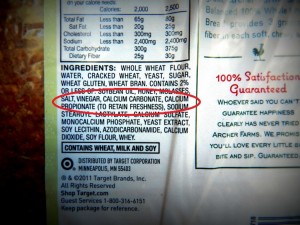
- Azodicarbonamide: Banned in both Europe and Australia, this industrial chemical is present in hundreds of our food products. It disrupts the body’s hormone regulation, weakens the immune system, irritates the skin, and can trigger asthma symptoms. Azodicarbonamide is very commonly added to bread products, even some of the whole wheat and whole grain varieties.

- Sucralose: Also known as Splenda, sucralose is most commonly found in light breads that are meant to be low calorie or low carb. A study in the Journal Of Toxicology And Environmental Health has linked this sugar substitute to a reduction in gut bacteria. We need our gut bacteria to properly break down food, absorb nutrients, and fight disease, just to name a few. Sucralose can also interfere with insulin and blood sugar regulation in the body.
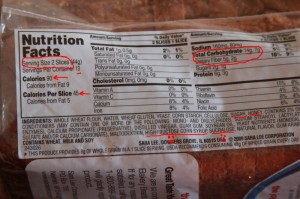
- Yellow food coloring: Yellow #5 is strongly linked to hyperactivity and aggressive behavior, and it may also contribute to blood cancer and thyroid cancer. Yellow #6 caused adrenal tumors in animal test subjects. The adrenal glands help regulate hormones in the body, so yellow #6 may act as a hormone disruptor. It is also linked to allergies and thyroid cancer.
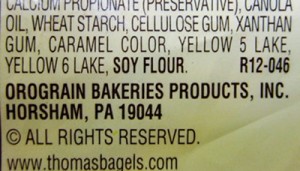
- Caramel coloring: This unnecessary additive caused lung cancer in animal test subjects and has also been linked to high blood pressure in humans. Recent quality control experiments with soda products found that the caramel coloring levels in many popular soda brands greatly exceed the limit that is considered safe. Some versions of caramel coloring may weaken the immune system and trigger allergies.
Other ingredients to watch out for – Datem, sodium stearoyl lactylate, calcium peroxide, mono and diglycerides.
Clearly, reading the ingredients label is important when buying bread. Some of the above items are completely unnecessary, such as yellow food coloring and caramel coloring. However, others serve valid purposes in keeping the bread “fresh” for long periods of time.
Traditional bread is baked and then eaten within a few days, so preservatives are not necessary. Store-bought bread has to stay good long enough to get from the facility where it’s made to the stores where it’s being sold, then sit there long enough to be purchased.
This is not an ideal way to buy bread because of the chemicals that are added to make this process possible. The best alternative is making your own bread, but if you aren’t willing to do that, then there are some store-bought types and brands that aren’t so bad.
Healthiest Types Of Bread:
- Sprouted grains bread: This is arguably the healthiest type that you can buy. It uses whole grains rather than flour. The process involves soaking grains in water until they begin to sprout, then harvesting the sprouts and grinding them up.
- Flaxseed bread: This is made with flax seeds, which are a healthy source of omega 3 and omega 6 fatty acids. Flax seeds also contain fiber and promote healthy digestion.
- Rye bread: This is made from whole rye grains. Rye bread is more filling than wheat bread, does not trigger a large insulin response after consumption, and can reduce bodily inflammation.
- Oat bread: Made from healthy whole oats, this type of bread contains more fiber and more protein than wheat bread. Compared to wheat bread, it also has more nutrients and is more filling.
Brands That Carry Healthy Bread Types:
- Food For Life
- Rudi’s Organic Bakery
- Dave’s Killer Bread
- Ancient Grains Bakery
- Manna Bread
Specific Examples Of Healthy Breads:
- Food For Life’s Ezekiel 4:9 Sprouted Grain Bread
- Manna Bread’s Sunseed Bread
- Canyon Bakehouse’s Gluten-Free Deli Rye Style Bread
- Rudi’s Spelt Ancient Grain Bread
Always check the ingredients label before buying bread, and try to go for 100% natural and organic whenever possible. Sprouted grains bread seems to be considered the best type among health-conscious consumers. Flaxseed, rye, and oat breads are also all healthy alternatives to wheat bread. Whole wheat and whole grain breads can be healthy as long as you make sure that they aren’t loaded with artificial chemicals and additives.
However, avoid white bread at all costs. White bread is so processed that it hardly contains any nutrients, and it is made with bleached white flour. The above healthy bread brands may seem pricey if you’re used to cheap white or wheat bread. If you can’t afford to buy high-quality bread, then you should look into making your own. It can be surprisingly cheap to create your own bread, and you’ll know it’s truly good for you.
If bread is causing digestive-related issues such as bloating, gas and indigestion, you might be suffering from wheat intolerance. Go to the next page and watch the 3 eating strategies to reduce these digestive-related issues –
About the Author:
Emma Deangela is the best selling author of The Alkaline Diet Program and 80/20 Fat Loss. She has helped over tens of thousands of men and women to lose weight and transform their health with sound nutrition advice.
What bread do you eat? Do you experience digestive problems when eating bread?
Please help them by sharing this eye-opening article with each of them using any of the social media and email buttons below.

Leave a Reply